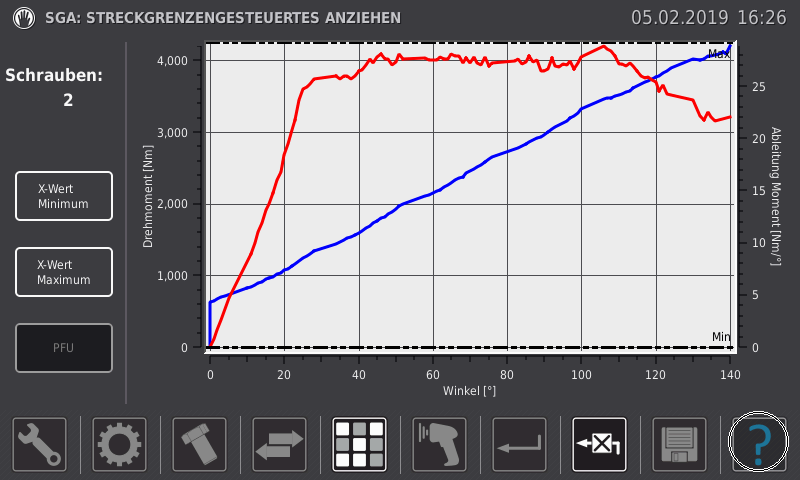SGA
Yield point-controlled tightening

This takes advantage of the fact that when tightening bolted joints by means of mutual torsion of the nut and the bolt not only AXIAL, but also TORSIONAL stress is used as a consequence of thread friction. Yielding of the bolt starts when the reference stress of tension and torsion reaches the material’s yield point. Immediately after the preload is applied, 50% of the torsion share in the bolt springs back. Therefore, the reference stress decreases, while the preload remains and the yield point-controlled preloaded connection re-gains an elastic connection reserve. Superelastic tightening of bolted joints by means of yield point-exceeding assembly methods (yield point- and rotation angle-controlled tightening) is used with increasing success. It allows for optimum use of the bolt during tightening and generates maximum possible assembly preloads.
This does not reduce the durability of the joint, but actually significantly improves it:
- the elastic spring back of the bolting system after assembly leads to partial relief of the torsion tension applied during tightening not only in the tensioned component, but also in the bolt. This releases stress reserves for later operational loads.
- With the plasticizing process in the bolt and nut thread while the preload is applied and exceeding the yield point, a constant distribution of the thread load is created, at least part of which remains even after relieving back to the elastic range.
- If further plasticizing of the bolt occurs due to the operating force FA, the bolt load relaxation FZ that is always linked to this will return the connection to the elastic deformation range.
In case of subsequent vibration stress at a preload level below the yield point, even higher durability values for the bolted joint can be achieved because of improved load distribution and possible load-indicated pressure-inherent tensions. This holds true for bolts rolled before and after heat treatment. The hydraulic yield point-controlled tightening is a superelastic tightening method in which the start of yielding of the bolt serves as the control parameter for the preload. Independent from the friction under the head, the bolt is tightened until the yield point is exceeded because of the load from tension and torsion stress.
Just like with hydraulic torque-angle-controlled tightening, the components have to be preloaded to a rotation angle starting torque. The rotation angle starting torque can be set according to pretighteing. The assembly process stops when the angle is exceeded, but can be continued upon the operator’s request. During further tightening, torque and rotation angle are continuously measured and the gradient is calculated. The measuring technology detects the end of the elastic range and ends the bolting process at the preset gradient change. As the bolt is only plasticly deformed to a very low degree, even bolted joints with short grip lengths can be tightened with the yield point-controlled method. During the tightening process, all process parameters are controlled, documented and archived by the Eco2TOUCH control. The plastic elongation of bolted joints during assembly is very small, so that it hardly influences the reusability of yield point-controlled bolted joints. The hardness of the application, the rotation angle starting torque and the shutoff criteria should be adapted to every individual bolted joint.
This tightening method is especially suitable for bolted joints with short grip lengths and for fastening systems on construction sites. Bolted joints that are hydraulically fastened with the yield point-controlled method can, in general, be reused. However, suitable lubricants have to be used to prevent seizure or fretting.